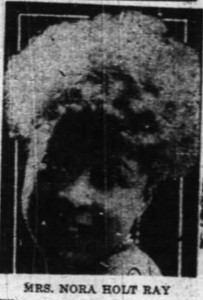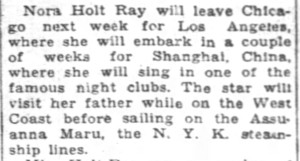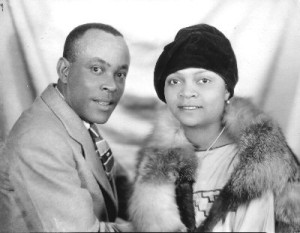How France added to the “Push” factors Causing a Jazz Explosion in inter-war Shanghai
Posted: September 19th, 2015 | No Comments »Plenty has been written on the popularity of Jazz in interwar Shanghai and the large number (comparatively) of African-American jazz musicians, singers and bands that passed through the city. I won’t rehash everything here – black musicians had been appearing in Shanghai since the early part of the twentieth century (as chronicled in a number of books including Andrew Field Shanghai’s Dancing World) and this process accelerated as Shanghai, both Chinese and Shanghailander, came to appreciate and want more jazz. The factors attracting African-American musicians and entertainers were multiple of course:
- Social – Shanghai was generally perceived as being somewhere with distinctly less prejudice, racism and exclusionary practices than America (mostly true, though racism both formal and informal did exist and was experienced – plenty of Shanghailanders were racist, some clubs and dancehalls operated informal colour bars while some places, like the American Club, operated formal bars; the 4th Marines stationed in the city were a fairly aggressive bunch too);
- Market – the growing demand for jazz in the city, the proliferation of venues and the perceived authenticity of black musicians (though obviously there was also a demand for white bands, either American, European or made up of Russians, Italians, Filipinos etc in Shanghai);
- Economic – for most of the period wages were pretty good, taxes low to non-existent and the exchange rate in America’s favour (though how you were paid, in what currency, whether you got cheated etc depended on the generosity or otherwise as well as the honesty of the employer).
Reading William A Shack”s Harlem in Montmartre, about the Paris jazz scene and specifically the crucial role of African-American musicians between the wars we can add another “push” factor that encouraged African-American entertainers to travel to Shanghai – the French 10% law…
Paris had of course been a Mecca to black American jazz musicians after World War One – black servicemen that stayed on after the Great War in the more liberal environment of Paris, more that came once word got out, others booked for European tours who found Paris congenial. However, in June 1933 France enacted the so-called 10% law. Enacted in the wake of the onset of the Great Depression in Europe the law restricted the number of foreign musicians employed by an establishment to 10%. This naturally caused a lot of unemployment and, while many stars and band leaders remained in work, many ordinary musicians found themselves unemployed.
Among those who found themselves struggling to make a living in Paris and lit out for Shanghai were:
- Bob and Teddy Drinkard – who took their floor show to the Canidrome Ballroom in Frenchtown
- Nora Holt Ray – a singer who worked in various Shanghai nightclubs
- Al Baldwin – who worked in Shanghai floor shows for six years
- Ulysses S (“Slow Kid”) Thompson – the husband of the (recently deceased) Florence Mills who got a gig at Shanghai’s Little Club
Of course after 1933, and things got tougher in Paris, American bands circumvented Europe and went straight to Shanghai with greater regularity. But it seems France’s decision to enact the 10% law saw a lot head straight to Marseilles and jump the Messagerie Maritime boat to Shanghai.



Leave a Reply